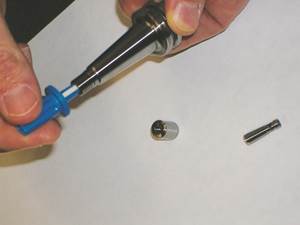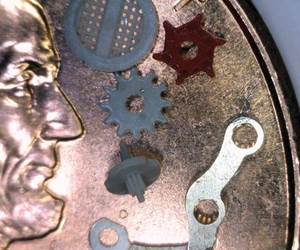Seduction or Intention: Choosing Your Time Wisely at IMTS
PMPA’s latest “Business Trends Report” shows that shops are busy working overtime and juggling their schedules to produce the almost unprecedented demand for components from our customers.
PMPA’s latest “Business Trends Report” shows that shops are busy working overtime and juggling their schedules to produce the almost unprecedented demand for components from our customers. In conversations, every manager, owner and engineer I speak with tells me the one thing they don’t have is any time at all to spare. And yet, when they get to the International Manufacturing Technology Show (IMTS), the chances are very good that their precious time will indeed be wasted at extraordinary displays of robot arms lifting sports cars, performers playing electric violins and who knows what other absurdities. If our time is worth “x” back home at the shop, it must certainly be some multiple of “x” when we are away after paying for airfare, hotel, meals, perhaps rental car and parking or cab fare and Uber.
So, what can be done to avoid being seduced away from our intention to find workable solutions to the issues our shops are facing now, such as the need for higher quality and productivity given the limits on available workforce and the ongoing demands of our customers? I’d like to suggest that you do a little pre-work, based on appreciative design, to help maximize the payoff from the time spent at the
big show.
Appreciative Design and Inquiry: It’s Like Problem Solving, Only Positive
Typical engineers or managers in our precision machining industry are well aware of the 5-Why process. Ask “Why” five times in a row, each time of the response previously given until the root cause is found. Appreciation is like that, but in a positive, visualizing way of trying to anticipate a desired future. The process? Instead of asking “Why” five times in a series, ask, “So what?” This will help get a clearer vision of the desired state, and the point is to recognize the existing positives and how to build on them.
In our industry, problem solving generally starts from a negative mindset. Something isn’t working or isn’t compliant and needs to be. The focus is on our weaknesses. In appreciative inquiry, the starting assumptions are about our strengths: what is working and how to build on these strengths to make them even more of a competitive advantage. Focus instead on our strengths. In appreciative inquiry, the appreciate part is about what we are already doing well and recognizing and valuing that as a strength. The inquiry part is about further exploring, analyzing and discovering ways to further improve. The focus is on building our positives.
The 5 ‘Ds’ of Appreciative Inquiry
Like the 5-S method for creating a lean workplace, there are five “Ds” to appreciative inquiry:
• Define
• Discover
• Dream
• Design
• Deliver
Define our desired future state is the first, and I would argue, most crucial step. This is done using positive language. We are not problem solving. We are designing an improved future. Positive language will keep us on a positive focus. Negative language starts us off in a negative light and drills too deep, too soon into process specifics. Accelerate to get results faster and shrink cycle times. This keeps our thinking broader and allows us to consider more possibilities. We are not looking for a single solution to a negative problem. We are looking broadly for a means to improve and enhance our shops’ ability to create and ship our high valued components.
Discovery is the next step. But before heading out of town to that really big show, discovery calls for us to “go to Gemba,” but to see what we are doing right, not wrong,
and what we could gain if we had further improvements. This is where we see what is best about our current systems and what we would like to see. This is the step where we listen to our people’s stories and start the conversation with our talent by asking them, “What do you appreciate most about …?” “What do you find most valuable …?” and “What is our most important…?” The discovery stage is the place for not only facts, but feelings as well. That’s part of the reason it is called appreciative. Listen to the stories of your performers. That is part of appreciation as well.
Dream is not about fantasies and umbrella drinks. This stage is about thoughtfully considering what might be, if we only dared. Starting with our positives, how can we craft our processes into an even more capable and desirable state? Nobody dreams with a list, but in appreciative inquiry, we will start with our list of positives to come up with a list that helps us create a positive message about the future we are going to create. Again, huddle with the team to collect some ideas for positive change.
Design. Your ISO certificate may not include design scope for manufacturing, but as a key member of the shop’s team, it is important to have design scope to intentionally declare what the desired future state for your shop is to be. What does that future state require? I’ll bet that systems, processes and strategies are essential to creating that future state. All of these are driven by the team. Select each of these based on your strengths. At IMTS, now is the time to validate what those systems, processes and strategies can deliver, based on one-on-one conversations with the experts there to communicate their products’ features and advantages. Now is the time to invest your attention on relevant potential technologies that can further enhance your shop’s already demonstrated capabilities. Let the other shops watch the robot lift the car.
Deliver. The first four Ds are important, but as managers in manufacturing, we understand the critical nature of being able to deliver. No one pays for dreams in manufacturing. Delivery is where we make our revenue. So, let’s deliver for ourselves. Focusing on that dream, “Parts go from production to packaging untouched by human hand… We now need to make the list of changes to be accomplished to move our organization to the desired future state.”
Some shops already have mature systems for managing and delivering change. In that case, just drop in the organization’s proven change management process for “Design and Deliver.”
IMTS is going to be awesome again this year. The distractions the marketers will deploy to lure us to spend time in their booths is certain to be even more incredible than the last time. But this time, we know the value of our time, based on the lengthening lead times at our shop. This just might be the year to skip the distractions and dream. Dream of a future where our processes are even more stable, our capabilities more defined and differentiated, and our customers find even more reasons to appreciate us being the shop they can count on in their supply chain.
Related Content
Metalworking Fluid Management and Best Practices
Cutting metal is a complex process involving many critical factors to be successful. Correctly applied metalworking fluids, including oils or coolant, is one of these critical factors.
Read MoreMicro-Drilling: 9 Questions to Answer Before Beginning
Applications for micromachining continue to grow. Successful machining with small tools calls for a different set of process skills on the shop floor.
Read MoreWhy Are We Writing About a Shop Making Custom Baseball Bats?
I recently learned about a 153-year-old manufacturer that has produced billions upon billions of precision, metal pins which started another business making one-off wooden baseball bats. (Like I asked it to do for me and you’ll see at this year’s Precision Machining Technology Show). Here I explain why it’s worth the time to read that article.
Read MoreUnderstanding Micro-Milling Machine Technology
Micro-milling can be a companion process to turning-based production machining. This article looks at some of the technologies that go into a micro-milling machine and why they are important to successful operation.
Read MoreRead Next
Do You Have Single Points of Failure?
Plans need to be in place before a catastrophic event occurs.
Read More5 Aspects of PMTS I Appreciate
The three-day edition of the 2025 Precision Machining Technology Show kicks off at the start of April. I’ll be there, and here are some reasons why.
Read MoreA Tooling Workshop Worth a Visit
Marubeni Citizen-Cincom’s tooling and accessory workshop offers a chance to learn more about ancillary devices that can boost machining efficiency and capability.
Read More







.png;maxWidth=300;quality=90)













